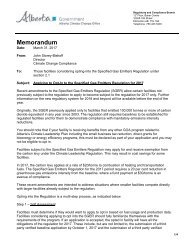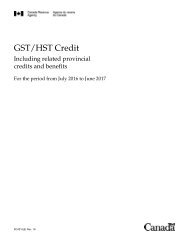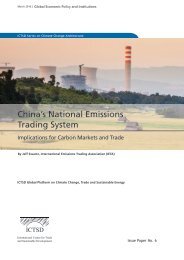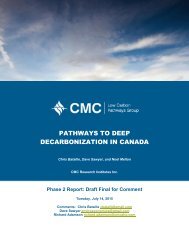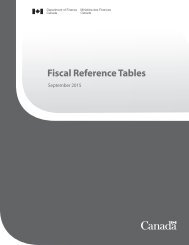MAKE THE ALBERTA CARBON LEVY REVENUE NEUTRAL
carbon-levy-revenue-neutral-mckenzie
carbon-levy-revenue-neutral-mckenzie
Create successful ePaper yourself
Turn your PDF publications into a flip-book with our unique Google optimized e-Paper software.
ate. Because the 10 per cent increase in the tax results in only an eight per cent increase in<br />
tax revenue, the total cost of raising a marginal dollar of tax revenue is approximately 10/8,<br />
or $1.25; the MCF in this case is 1.25. 12<br />
That additional 25 cents, over and above the $1 in incremental tax revenue raised, is the<br />
efficiency cost associated with raising an additional dollar of tax revenue. It arises because<br />
the size of the tax base shrinks due to the behavioural effects associated with the increase<br />
in the tax rate. The sensitivity of the tax base to the tax rate will differ across different<br />
types of taxes. All else being equal, the more sensitive a tax base is to an increase in the tax<br />
rate, (the more the tax base shrinks in response to an increase in the tax rate), the higher<br />
will be the efficiency cost of the tax and the higher the MCF.<br />
In two recent very valuable and timely School of Public Policy research papers, Bev Dahlby<br />
and Ergete Ferede calculate the tax base sensitivities and the MCF of the three major types<br />
of taxes in Canadian provinces: corporate income taxes (CIT), personal income taxes (PIT),<br />
and general sales taxes (GST). 13 Their calculations are reproduced in Table 1. I focus here<br />
on the calculations for Alberta, and in particular on the implications of these calculations<br />
for the argument for the revenue neutrality of carbon taxes.<br />
The MCF for the CIT for Alberta is 3.79. This means that if Alberta increased its statutory<br />
CIT rate to raise an incremental dollar in revenue, and the tax rates in the other provinces<br />
remained the same, this would impose an additional, and somewhat astonishing, $2.79 in<br />
costs on the Alberta economy over and above the incremental $1 in tax revenue raised, due<br />
to the efficiency costs arising from the shrinkage in the corporate tax base. This is due in<br />
large part to the sensitivity of the corporate tax base to changes in the tax rate. Dahlby and<br />
Ferede estimate that a one-percentage-point increase in the statutory CIT rate for Alberta is<br />
associated with about a 13 per cent decrease in the corporate tax base.<br />
At 1.71, the MCF for the PIT is smaller, but still significant. Raising one more dollar in<br />
revenue by increasing the personal income tax rate generates an incremental $0.71 in<br />
economic costs. Notably, the MCF for a general sales tax in Alberta is 1.0. The reason<br />
for this is that Alberta does not levy a general sales tax, which means that at the margin,<br />
raising an incremental dollar in revenue from a sales tax imposes no additional costs on<br />
the economy. This is the typical argument for imposing a sales tax in Alberta (another<br />
argument for another day).<br />
12<br />
13<br />
This example is taken from Dahlby and Ferede (2011). As they point out, it is an approximation because the 10 per cent<br />
increase in the tax is not literally a marginal increase as it will generate more than $1. Technically, an infinitesimal increase<br />
in the tax is required. See Dahlby (2008) for a more rigorous treatment.<br />
Dahlby and Ferede (2016a, 2016b).<br />
6



